常用速记符号
- 格式:doc
- 大小:48.50 KB
- 文档页数:11
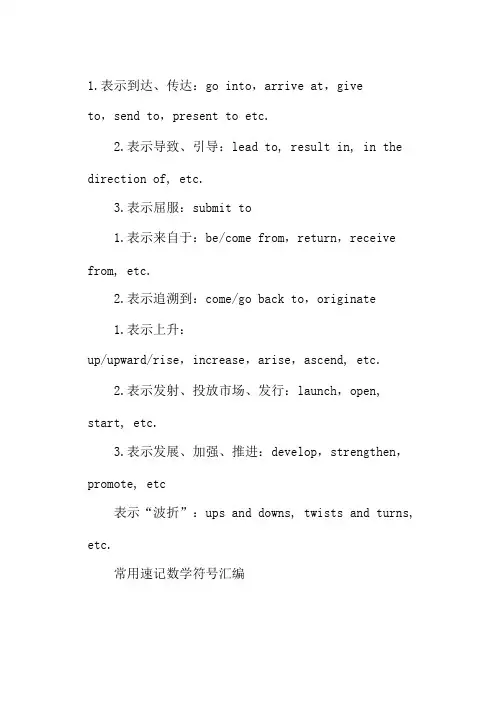
1.表示到达、传达:go into,arrive at,giveto,send to,present to etc. 2.表示导致、引导:lead to, result in, in the direction of, etc. 3.表示屈服:submit to 1.表示来自于:be/come from,return,receive from, etc. 2.表示追溯到:come/go back to,originate 1.表示上升:up/upward/rise,increase,arise,ascend, etc. 2.表示发射、投放市场、发行:launch,open, start, etc. 3.表示发展、加强、推进:develop,strengthen,promote, etc 表示“波折”:ups and downs, twists and turns, etc. 常用速记数学符号汇编 +表示“多”: many, lots of, a great deal of, a good many of, etc. ++(+2)表示“多”的比较级:more +3表示“多”的最高级:most -表示“少”: little, few, lack ,in short of/ be in shortage of etc. ×表示“错误”、“失误”和“坏”的概念:wrong/incorrect,somethingbad,notorious,negative, etc. > 1.表示“多于”概念:bigger/larger/greater/more than/better than, etc. 2.表示“高” 概念:superior to,surpass, etc. < 1.表示“少于”概念:less/smaller,etc. 2.表示“低”概念:inferior to,etc. =1.表示“同等”概念:means,that is to say,in other words,the same as,be equal to, etc. 2.表示“对手”概念:a match, rival, competitor, counterpart, etc. ( )表示“在......之间”:among, within, etc. ≠1.表示“不同”概念:be different from, etc. 2.表示“无敌”概念:matchless, peerless, etc. ~表示“大约”概念:about/around,or so,approximately, etc. /表示“否定”,“消除”等概念:cross out, eliminate, etc. 记笔记:常用符号和缩略语 (Note-taking: Useful Signs and Abbreviations) 1. 常用笔记符号: 符号信息意义 箭头符号 ↑上升;提高;增强;上涨;增长;扩大;起飞;升空;提拔;晋升 (grow, expand, develop, rise, go up, increase , ascend, launch, skyrocket, soar, appreciation, promote, upwards) ↓下降;下沉;降低;滑坡;轰炸;减少;恶化;降职;削减/裁减(drop to, bomb, jump, go down, descend,decrease, deteriorate, depreciation, reduce, downwards) ↗上扬;渐渐好转(become better and better) ↘下挫;不断亏损(become worse and worse) →出口;去;向前;出国;前往;运往;导致;发展成为… (export to, enter, arrive in/at, present to, result in, send to, transmit to, lead to, export to, cause) ←回顾;从前;进口;倒退;来自;源于(come from, originate from, receive from, go back to, import from)例如:café ← French意为: café源自于法语 数学符号 + 增加;补充;除此之外另外(furthermore, in addition to, with, and, besides, etc) — 减少;删除;缺乏(minus, lack) × 表示“不对的,错的,坏的,不好的,臭名昭著的”(incorrect, wrong, bad, inappropriate, notorious) > 超过,大于,胜过,优于(more than, bigger than, surpass, better than, superior to) < 小于,不足,次于,逊色(fewer than, less than, worse than, inferior to) = 等于符号(equal) 在听力笔记中相当于“与…一样”(equal to, the same as),另外可以表示“是…的对手“(a ri-val, a competitor)等意思。
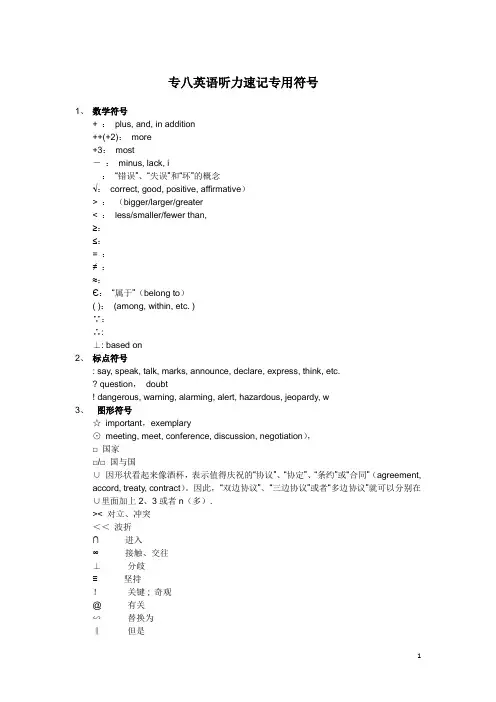
专八英语听力速记专用符号1、数学符号+ :plus, and, in addition++(+2):more+3:most-:minus, lack, i×:“错误”、“失误”和“坏”的概念√:correct, good, positive, affirmative)> :(bigger/larger/greater< :less/smaller/fewer than,≥:≤:= :≠ :≈:Є:“属于”(belong to)( ):(among, within, etc. )∵:∴:⊥: based on2、标点符号: say, speak, talk, marks, announce, declare, express, think, etc.? question,doubt! dangerous, warning, alarming, alert, hazardous, jeopardy, w3、图形符号☆important,exemplary⊙meeting, meet, conference, discussion, negotiation),□ 国家□/□ 国与国∪因形状看起来像酒杯,表示值得庆祝的“协议”、“协定”、“条约”或“合同”(agreement, accord, treaty, contract)。
因此,“双边协议”、“三边协议”或者“多边协议”就可以分别在∪里面加上2、3或者n(多).>< 对立、冲突<<波折∩ 进入∞ 接触、交往⊥ 分歧≡ 坚持! 关键 ; 奇观@ 有关∽ 替换为‖ 但是○ 洞& 表示“和”,“与”:and,together with,along with,accompany,along with,further more,etc.#表示“结束”:end,stop,halt,bring sth to a standstill /stop, etc.∟ 加在动词下表示“过去”、“……过”或“……了”」加在动词下表示“将来”※特征、特点(feature, character, characteristic, symbol, sign, exemplify)∧领导♀ female♂ male4、箭头符号↑ 表示“上升”、↓ 表示“减少”、← 原因、→ 导致、结果5、惯用符号(缩写)(1) 常用字母c表示“世纪”(century),比如“21世纪”可以写成21ce表示“经济”(economy, economic, economics)n表示“很多个”(many, much, several)(2) 英文缩写(适用于高频词)a.保留前几个字母Com:Edu:e.g.:info:IOU:I/O:ASAP:Max:Min:Esp:b. 拿掉所有元音MKT:MSG:STD:RCV:ACPT:AD:DEPT:STD:c.保留开头和结尾的辅音字母WK:d.根据发音R; U; UR;。
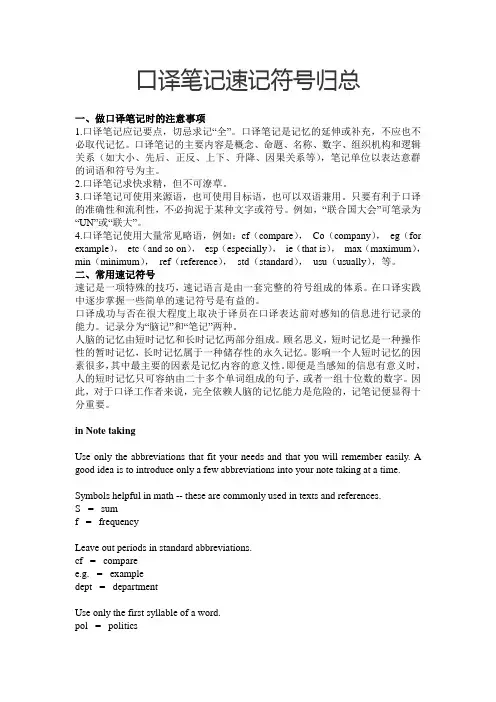
口译笔记速记符号归总一、做口译笔记时的注意事项1.口译笔记应记要点,切忌求记“全”。
口译笔记是记忆的延伸或补充,不应也不必取代记忆。
口译笔记的主要内容是概念、命题、名称、数字、组织机构和逻辑关系(如大小、先后、正反、上下、升降、因果关系等),笔记单位以表达意群的词语和符号为主。
2.口译笔记求快求精,但不可潦草。
3.口译笔记可使用来源语,也可使用目标语,也可以双语兼用。
只要有利于口译的准确性和流利性,不必拘泥于某种文字或符号。
例如,“联合国大会”可笔录为“UN”或“联大”。
4.口译笔记使用大量常见略语,例如:cf(compare),Co(company),eg(for example),etc(and so on),esp(especially),ie(that is),max(maximum),min(minimum),ref(reference),std(standard),usu(usually),等。
二、常用速记符号速记是一项特殊的技巧,速记语言是由一套完整的符号组成的体系。
在口译实践中逐步掌握一些简单的速记符号是有益的。
口译成功与否在很大程度上取决于译员在口译表达前对感知的信息进行记录的能力。
记录分为“脑记”和“笔记”两种。
人脑的记忆由短时记忆和长时记忆两部分组成。
顾名思义,短时记忆是一种操作性的暂时记忆,长时记忆属于一种储存性的永久记忆。
影响一个人短时记忆的因素很多,其中最主要的因素是记忆内容的意义性。
即便是当感知的信息有意义时,人的短时记忆只可容纳由二十多个单词组成的句子,或者一组十位数的数字。
因此,对于口译工作者来说,完全依赖人脑的记忆能力是危险的,记笔记便显得十分重要。
in Note takingUse only the abbreviations that fit your needs and that you will remember easily. A good idea is to introduce only a few abbreviations into your note taking at a time. Symbols helpful in math -- these are commonly used in texts and references.S = sumf = frequencyLeave out periods in standard abbreviations.cf = comparee.g. = exampledept = departmentUse only the first syllable of a word.pol = politicslib = liberalcap = capitalismUse entire first syllable and only 1st letter of 2nd syllable.pres = presentationsubj = subjectind = individualcons = conservativeEliminate final letters. Use just enough of the word to form a recognizable abbreviation.assoc = associatebiol = biologyinfo = informationach = achievementchem = chemistrymax = maximumintro = introductionconc = concentrationmin = minimumrep = repetitionOmit vowels, retain only enough consonants to give a recognizable skeleton of the word.ppd = preparedprblm = problemestmt = estimatebkgd = backgroundgvt = governmentUse an apostrophe in place of letters.am't = amountcont'd = continuedgov't = governmenteducat'l = educationalForm the plural of a symbol or abbreviated word by adding s.chpts = chaptersegs = examplesfs = frequenciesintros = introductionsUse g to represent ing endings.estg = establishingdecrg = decreasingexptg = experimentingSpell out short words such as in, at, to, but, for, and key.Abbreviations or symbols for short words will make the notes too dense with shorthand.Leave out unimportant words.Leave out the words a and the.If a term, phrase, or name is written out in full during the lecture, substitute initials whenever the term, phrase, or name is used again. For example, Center for Aerospace Sciences becomes CAS thereafter.Use symbols for commonly recurring connective or transitional words.& = andw/ = withw/o = withoutvs = against\ = therefore= = is or equalUse technical symbols where applicable.zb = German, for exampleibid = Latin, the same worko = degreesH2O = waterMore reference:Use standard maths, accounting, and science symbols. Examples:+ plus// parallelUse standard abbreviations and leave out full stops. Examples:eg exampleIT dept Information Technology departmentUK United KingdomUse only the first syllable of a word. Examples:mar marketingcus customercli clientUse the entire first syllable and the first letter of the second syllable. Examples:subj subjectbudg budgetind individualTo distinguish among various forms of the same word, use the first syllable of the word, an apostrophe, and the ending of the word. Examples:tech'gy technologygen'ion generalisationdel'y deliveryUse just enough of the beginning of a word to form a recognisable abbreviation. Examples:assoc associatedach achievementinfo informationOmit vowels from the middle of words, retaining only enough consonants to provide a recognisable skeleton of the word. Examples:bkgd backgroundmvmt movementprblm problemForm the plural of a symbol or abbreviated word by adding 's.' Examples:custs customersfs frequencies/s ratiosUse 'g' to represent 'ing' endings. Examples:decrg decreasingckg checkingestblg establishingSpell out, rather than abbreviate short words. Examples:inbutaskeyLeave out unimportant verbs. Examples:iswaswereLeave out unnecessary articles. Examples:aantheIf a term, phrase, or name is initially written out in full during the talk or meeting, initials can be substituted whenever the term, phrase, or name is used again. Example: January Advertising Campaign Budget JACBUse symbols for common connective or transition words. Examples:@ at2 to4 for& andw/ withw/o withoutvs againstCreate your own set of abbreviations and symbols. You may wish to develop separate sets of symbols and abbreviations for different courses or subjects.Other Symbols and Abbreviationsas a result of / consequences of <--->resulting in --->and / also +equal to / same as =following ffmost importantly *less than <greater than > especially esp/一、缩略词英语当中缩略词使用的频率很高,如IMP: important, ASAP: as soon as possible。
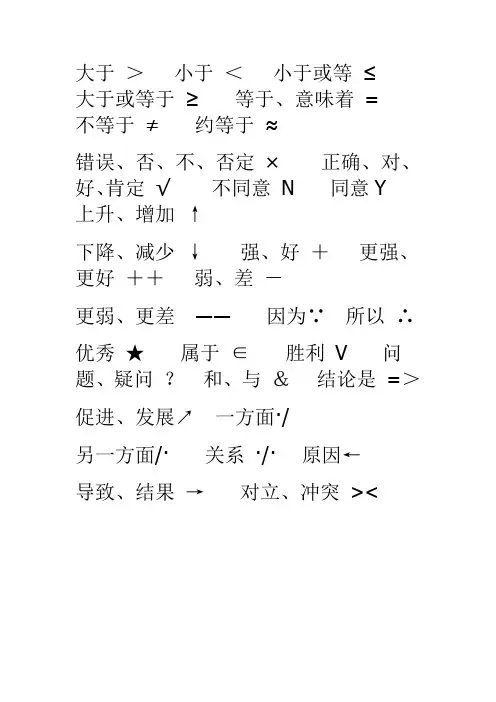
大于>小于<小于或等≤
大于或等于≥等于、意味着= 不等于≠约等于≈
错误、否、不、否定×正确、对、好、肯定√不同意N 同意Y 上升、增加↑
下降、减少↓强、好+更强、更好++弱、差-
更弱、更差――因为∵所以∴
优秀★属于↔胜利V 问题、疑问?和、与&结论是=>
促进、发展↗一方面·/
另一方面/·关系·/·原因←
导致、结果→对立、冲突><
笔记的主要内容是概念、命题、名称、数字、组织机构和逻辑关系(如大小、先后、正反、上下、升降、因果关系等),笔记单位以表达意群的词语和符号为主。
笔记可使用来源语,也可使用目标语,也可以双语兼用。
笔记使用大量常见略语,例如:eg(for example), etc(a nd so on), esp(especially), ie(that is), max(maximum), min(minimum), ref (reference), std(standard), usu(usuall y),等。
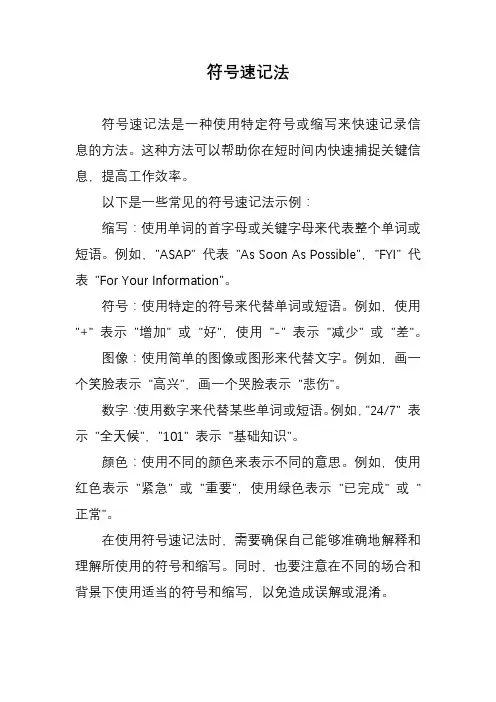
符号速记法
符号速记法是一种使用特定符号或缩写来快速记录信息的方法。
这种方法可以帮助你在短时间内快速捕捉关键信息,提高工作效率。
以下是一些常见的符号速记法示例:
缩写:使用单词的首字母或关键字母来代表整个单词或短语。
例如,"ASAP" 代表"As Soon As Possible","FYI" 代表"For Your Information"。
符号:使用特定的符号来代替单词或短语。
例如,使用"+" 表示"增加" 或"好",使用"-" 表示"减少" 或"差"。
图像:使用简单的图像或图形来代替文字。
例如,画一个笑脸表示"高兴",画一个哭脸表示"悲伤"。
数字:使用数字来代替某些单词或短语。
例如,"24/7" 表示"全天候","101" 表示"基础知识"。
颜色:使用不同的颜色来表示不同的意思。
例如,使用红色表示"紧急" 或"重要",使用绿色表示"已完成" 或"正常"。
在使用符号速记法时,需要确保自己能够准确地解释和理解所使用的符号和缩写。
同时,也要注意在不同的场合和背景下使用适当的符号和缩写,以免造成误解或混淆。
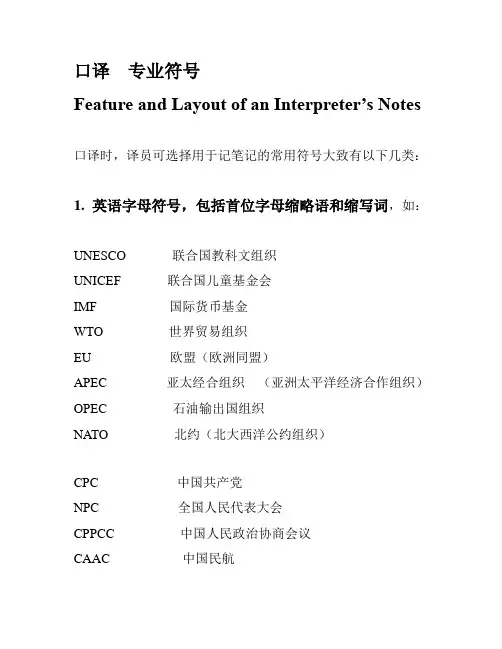
口译专业符号Feature and Layout of an Interpreter’s Notes口译时,译员可选择用于记笔记的常用符号大致有以下几类:1. 英语字母符号,包括首位字母缩略语和缩写词,如:UNESCO 联合国教科文组织UNICEF 联合国儿童基金会IMF 国际货币基金WTO 世界贸易组织EU 欧盟(欧洲同盟)APEC 亚太经合组织(亚洲太平洋经济合作组织)OPEC 石油输出国组织NATO 北约(北大西洋公约组织)CPC 中国共产党NPC 全国人民代表大会CPPCC 中国人民政治协商会议CAAC 中国民航CCTV 中央电视台PLA 中国人民解放军HKSAR 香港特别行政区GDP 国民生产总值Ch. govt. 中国政府re. op. 改革开放4 Ms 四个现代化tot. imp 进口总额tot. exp 出口总额NASA 美国宇航局FBI 美国联邦调查局GM 美国通用汽车公司AT&T 美国电话电报公司US/Am. 美国UK/Br. 英国Can. 加拿大AUS. 澳大利亚N.Z. 新西兰NY 纽约Las. 洛杉矶US$ 美元Br£英镑Can$ 加元Euro 欧元$A 澳元NZ$ 新西兰元HK$ 香港元RMB 人民币2. 用各种数学符号,如:∴所以∵因为= 等于或就是,意味着≠ 不等于,不是≈ 大约,大概,左右> 大于,多于,比…大< 小于,少于,比…小3. 用译员自己创造的各种形象符号,如:×不同意,不赞成,错误,不正确√ 同意,赞成,正确→ 从某地到某地,从某时到某时,导致,引起← 过去,回忆,返回,后退,倒退↓ 下降,降低,减少,向下↑ 上升,提高,增加,向上□←来访,进入,进口,引进外资,来华投资□→ 出访,外出,出口,海外投资☆杰出,优秀,最佳,突出,标兵,榜样∽交换,交流,交替,互换3—, —300,0005,—, —5,000,000常用口译符号:equal: =boost, improve, enhance, strengthen :↗plus: +minus: —times: xdivided by: ÷degree: ℃percent: %per thousand: ‰between:|.|because, because of, due to: ∵therefore, so, as a result, consequently: ∵plus or minus: ±versus, the ratio of, divided by : :so on, etc, and so forth : ···is (much) greater/bigger/larger/faster/quicker /heavier/older… than; superior to, surpass: > is (much) less/smaller/lighter/younger/fewer/inferior to/worse than…: <not equal to : ≠not less than: ≥varies as, in direct proportion to: ∝或∞ parallel, is parallel to : ‖right angle: ∟perpendicular, is perpendicular to: ⊥circle, circumference: ○ellipse: 0diameter: θtriangle, delta : △pressure, influence: ⊥ (竖线为向下箭头) approximately, about, nearly, around, almost: ≈as always, 一直,总是,一贯:≡into:→contact, exchanges: ∞conflicts, disputes, contradictions: ><波折:<<belong to, is of ,of: ∈victory, win, success : Vby, with, %, in: /as always, hold on, persist, insist on :≡wonder, miracle : !About: @On the one hand:∕On the other hand: ∕Relation, relationship: &Not agree: NAgree: YFine, good: +Better, much better:++Bad, weak: -Worse, weaker: - -In conclusion : =>Empty: ORepresentative, delegation, delegation: △2. 货币:sterling, pound: £US dollar: US$renminbi: RMB: ¥Australian dollars: #AAustrian schillings: SchCanadian dollars: Can$Eurodollar: €口译笔记符号:缩略词缩略词的写法一般为四种方式:1..拿掉所有元音MKT: marketMGR: managerMSG: messageSTD: standardRCV: receive2. 保留前几个字母INFO:informationINS:insuranceEXCH:exchangeI owe you:IOUIn stead of :I/O3. 保留开头和结尾个发音字母WK weekRM roomPL people4. 根据发音R areTHO thoughTHRU through数学符号+ 表示"多": many, lots of, a great deal of, a good many of, etc.++(+2) 表示"多"的比较级:more+3 表示"多"的最高级:most-表示"少": little, few, lack ,in short of/ be in shortage of etc.×表示"错误"、"失误"和"坏"的概念:wrong/incorrect,something bad,notorious,negative, etc.> 表示"多于"概念:bigger/larger/greater/more than/better than, etc.表示"高" 概念:superior to,surpass, etc.< 表示"少于"概念:less/smaller,etc.表示"低"概念:inferior to,etc.= 表示"同等"概念:means,that is to say,in other words,the same as,be equal to, etc.←→表示"对手"概念:a match, rival, competitor, counterpart, etc. ( ) 表示"在......之间":among, within, etc.≠ 表示"不同"概念:be different from, etc.~表示"大约"概念:about/around,or so,approximately, etc. / 表示"否定","消除"等概念:cross out, eliminate, etc.标点符号等: 表示各种各样"说"的动词:say, speak, talk, marks, announce, declare, etc.? 表示"问题":question,issue,例如:台湾问题:tw?. (dot) 点的位置不同表示的概念也不一样".d"表示yesterday, ".y"表示last year, ".2m"表示two month ago。
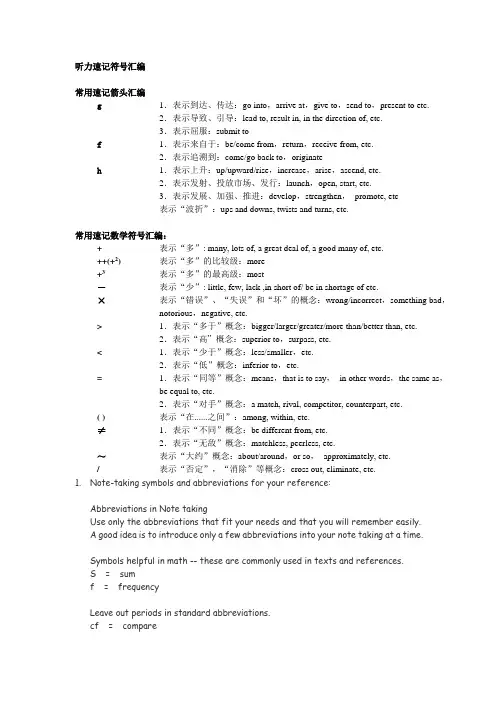
听力速记符号汇编常用速记箭头汇编g1.表示到达、传达:go into,arrive at,give to,send to,present to etc.2.表示导致、引导:lead to, result in, in the direction of, etc.3.表示屈服:submit tof1.表示来自于:be/come from,return,receive from, etc.2.表示追溯到:come/go back to,originateh1.表示上升:up/upward/rise,increase,arise,ascend, etc.2.表示发射、投放市场、发行:launch,open, start, etc.3.表示发展、加强、推进:develop,strengthen,promote, etc表示“波折”:ups and downs, twists and turns, etc.常用速记数学符号汇编:+表示“多”: many, lots of, a great deal of, a good many of, etc.++(+2)表示“多”的比较级:more+3表示“多”的最高级:most-表示“少”: little, few, lack ,in short of/ be in shortage of etc.×表示“错误”、“失误”和“坏”的概念:wrong/incorrect,something bad,notorious,negative, etc.> 1.表示“多于”概念:bigger/larger/greater/more than/better than, etc.2.表示“高” 概念:superior to,surpass, etc.< 1.表示“少于”概念:less/smaller,etc.2.表示“低”概念:inferior to,etc.=1.表示“同等”概念:means,that is to say,in other words,the same as,be equal to, etc.2.表示“对手”概念:a match, rival, competitor, counterpart, etc.( )表示“在......之间”:among, within, etc.≠1.表示“不同”概念:be different from, etc.2.表示“无敌”概念:matchless, peerless, etc.~表示“大约”概念:about/around,or so,approximately, etc./表示“否定”,“消除”等概念:cross out, eliminate, etc.1.Note-taking symbols and abbreviations for your reference:Abbreviations in Note takingUse only the abbreviations that fit your needs and that you will remember easily.A good idea is to introduce only a few abbreviations into your note taking at a time.Symbols helpful in math -- these are commonly used in texts and references.S = sumf = frequencyLeave out periods in standard abbreviations.cf = comparedept = departmentUse only the first syllable of a word.pol = politicsdem = democracylib = liberalcap = capitalismUse entire first syllable and only 1st letter of 2nd syllable.pres = presentationsubj = subjectind = individualcons = conservativeEliminate final letters. Use just enough of the word to form a recognizable abbreviation.assoc = associatebiol = biologyinfo = informationach = achievementchem = chemistrymax = maximumintro = introductionconc = concentrationmin = minimumrep = repetitionOmit vowels, retain only enough consonants to give a recognizable skeleton of the word.ppd = preparedprblm = problemestmt = estimatebkgd = backgroundgvt = governmentUse an apostrophe in place of letters.am't = amountcont'd = continuedgov't = governmenteducat'l = educationalForm the plural of a symbol or abbreviated word by adding s.chpts = chaptersegs = examplesintros = introductionsUse g to represent ing endings.ckg = checkingestg = establishingdecrg = decreasingexptg = experimentingSpell out short words such as in, at, to, but, for, and key.Abbreviations or symbols for short words will make the notes too dense with shorthand.Leave out unimportant words.Leave out the words a and the.If a term, phrase, or name is written out in full during the lecture, substitute initials whenever the term, phrase, or name is used again. For example, Center for Aerospace Sciences becomes CAS thereafter.Use symbols for commonly recurring connective or transitional words.& = andw/ = withw/o = withoutvs = against\ = therefore= = is or equalUse technical symbols where applicable.zb = German, for exampleibid = Latin, the same worko = degreesH2O = waterMore reference:Use standard maths, accounting, and science symbols. Examples:+ plus// parallelUse standard abbreviations and leave out full stops. Examples:eg exampleIT dept Information Technology departmentUK United KingdomUse only the first syllable of a word. Examples:mar marketingcus customercli clientUse the entire first syllable and the first letter of the second syllable. Examples: subj subjectbudg budgetind individualTo distinguish among various forms of the same word, use the first syllable of the word, an apostrophe, and the ending of the word. Examples:tech'gy technologygen'ion generalisationdel'y deliveryUse just enough of the beginning of a word to form a recognisable abbreviation. Examples:assoc associatedach achievementinfo informationOmit vowels from the middle of words, retaining only enough consonants to provide a recognisable skeleton of the word. Examples:bkgd backgroundmvmt movementprblm problemForm the plural of a symbol or abbreviated word by adding 's.' Examples: custs customersfs frequencies/s ratiosUse 'g' to represent 'ing' endings. Examples:decrg decreasingckg checkingestblg establishingSpell out, rather than abbreviate short words. Examples:inbutaskeyLeave out unimportant verbs. Examples:iswaswereLeave out unnecessary articles. Examples:aantheIf a term, phrase, or name is initially written out in full during the talk or meeting,initials can be substituted whenever the term, phrase, or name is used again. Example:January Advertising Campaign Budget JACBUse symbols for common connective or transition words. Examples:@ at2 to4 for& andw/ withw/o withoutvs againstCreate your own set of abbreviations and symbols. You may wish to develop separate sets of symbols and abbreviations for different courses or subjects. Other Symbols and Abbreviationsas a result of / consequences of <--->resulting in --->and / also +equal to / same as =following ffmost importantly *less than <greater than > especially esp/一、缩略词英语当中缩略词使用的频率很高,如IMP: important, ASAP: as soon as possible。
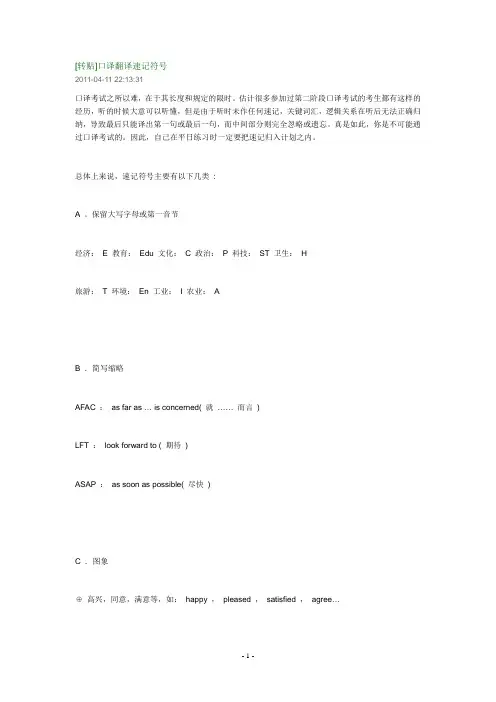
[转贴]口译翻译速记符号2011-04-11 22:13:31口译考试之所以难,在于其长度和规定的限时。
估计很多参加过第二阶段口译考试的考生都有这样的经历,听的时候大意可以听懂,但是由于听时未作任何速记,关键词汇,逻辑关系在听后无法正确归纳,导致最后只能译出第一句或最后一句,而中间部分则完全忽略或遗忘。
真是如此,你是不可能通过口译考试的。
因此,自己在平日练习时一定要把速记归入计划之内。
总体上来说,速记符号主要有以下几类:A 。
保留大写字母或第一音节经济:E 教育:Edu 文化: C 政治:P 科技:ST 卫生:H旅游:T 环境:En 工业:I 农业:AB .简写缩略AFAC :as far as … is concerned( 就……而言)LFT :look forward to ( 期待)ASAP :as soon as possible( 尽快)C .图象⊕高兴,同意,满意等,如:happy ,pleased ,satisfied ,agree…◎悲伤,生气,不满,不同意等,如:sad ,angry ,irritated ,unsatisfied ,sorrowful ,discomfort ,disagree…⊙会议,如conference ,meeting ,seminar ,symposium…□国家,地区,如:中国:□ C ,俄国:□ RD .符号﹢高兴,男性,同意,增加等,如happy ,male ,agree ,many ,+2=more ,+3=most ,beneficial ,good ,beautiful ,great ,gorgeous…-悲伤,女性,不同意,减少等,如sad ,female ,disagree ,little ,few ,-2=less ,-3=least ,lack of ,short of…√同意,正确等,如:agree ,correct ,right…×不同意,错误等,如:disagree ,incorrect…↑增长,进步等,如:increase ,soar ,mushroom ,rocket ,make progress…↓下降,退步,恶化等,如decrease ,sink ,slide ,subside ,plump ,plunge ,drop ,degrade ,deteriorate…>多于,超过,比……低一级等,如:more than ,greater than ,begger than ,better than ,superior to ,surpass ,transcend ,overtake…<少于,比……低级等,如:less than ,lower than ,smaller than ,inferior to…~大约,如:approximately ,about ,around ,some ,nearly ,almost ,similar to…/否定,清除,如:clear ,settle ,solve ,tackle ,conquer ,eliminate ,extinct…≠与……不同,如:differ from ,different from ,distinct ,unique…$ 金钱,利益,如:interest ,benefit ,money ,fund ,capital…E .标点? 问题,麻烦,障碍,如:question ,issue ,difficult ,hardship ,barrier ,obstacle…: 主观想法和说辞,如:think ,consider ,speak ,say ,talk ,mark ,announce ,declare ,hope ,例:repeat 或reaffirm 可以用:2 来替代,声明支持可以用+ :来替代,谴责用- :。
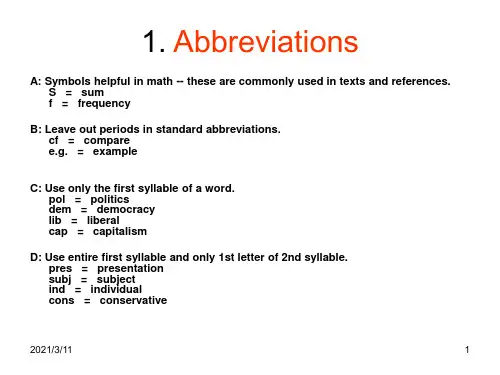
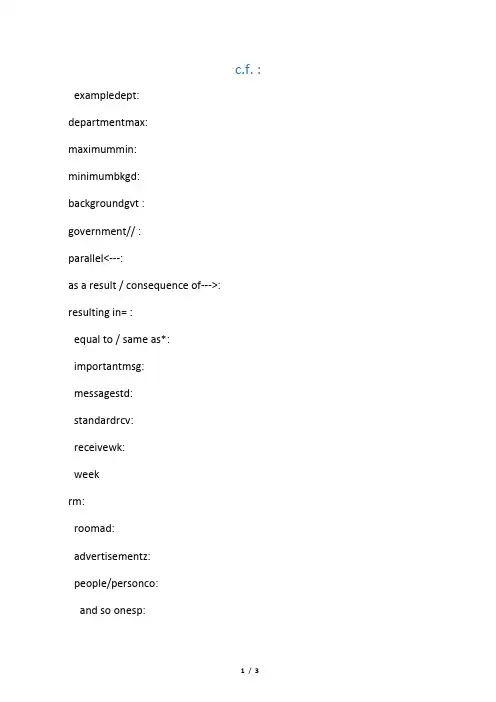
c.f. : exampledept:departmentmax:maximummin:minimumbkgd:backgroundgvt :government// :parallel<---:as a result / consequence of--->: resulting in= :equal to / same as*: importantmsg:messagestd:standardrcv:receivewk:weekrm:roomad:advertisementz:people/personco:and so onesp:especiallyie:that is≈:about, approximate, or so,↑:increase↓:decrease∈:belongV:victory↗:development>< conflict, confrontation<<:difficulty⊙:conference, meeting∞:disagreement, discrepancy∽:in stead of△:stand for?:question∧:but, however( ):among, within, etctm:time∵:by reason that, because, owing to, inasmuch as; on the score of;in so much as; considering that; nowthat∴:therefore, so; consequently+ :many, lots of, a great deal of, a good many of, etc. (++(+2):more, +3:most)-:little, few, lack ,in short of/ be in shortage of etc.×:wrong/incorrect,something bad√:right/good>:bigger/larger/greater/more than/better than, superior to,surpass, etc.<:less/smaller,inferior to,etc.=:means,that is to say,in other words,the same as,be equal to, etc.::say, speak, talk, marks, announce, declare, etc.. (dot)这个"."点的位置不同表示的概念也不一样".d"表示yesterday, ".y"表示last year, ".2m"表示twomonth ago。
口译成功与否在很大程度上取决于译员在口译表达前对感知的信息进行记录的能力。记录分为“脑记”和“笔记”两种。 人脑的记忆由短时 记忆和长时记忆两部分组成。顾名思义,短时记忆是一种操作性的暂时记忆,长时记忆属于一种储存性的永久记忆。影响一个人短时记忆的因素很多,其中最主要的 因素是记忆内容的意义性。即便是当感知的信息有意义时,人的短时记忆只可容纳由二十多个单词组成的句子,或者一组十位数的数字。因此,对于口译工作者来 说,完全依赖人脑的记忆能力是危险的,记笔记便显得十分重要。 做口译笔记时的注意事项 1. 口译笔记应记要点,切忌求记“全”。口译笔记是记忆的延伸或补充,不应也不必取代记忆。口译笔记的主要内容是概念、命题、名称、数字、组织机构和逻辑关系 (如大小、先后、正反、上下、升降、因果关系等),笔记单位以表达意群的词语和符号为主。 2.口译笔记求快求精,但不可潦草。 3.口译笔记可使用来源语,也可使用目标语,也可以双语兼用。只要有利于口译的准确性和流利性,不必拘泥于某种文字或符号。例如,“联合国大会”可笔录为 “UN”或“联大”。 4.口译笔记使用大量常见略语,例如:cf(compare), Co(company), eg(for example), etc(and so on), esp(especially), ie(that is), max(maximum), min(minimum), ref(reference), std(standard), usu(usually),等。
有效的笔记系统 影响口译质量的一大原因是笔记得当与否 口译笔记是辅助记忆的手 段,是在听讲过程中用简单的文字或符号记下讲话内容中能刺激记忆的关键词。通过关键词能够提示考生讲话人所表述的意思,掌握其表述内容的前因后果、上下文 的逻辑关系。除此之外,数字、地点、人名容易一听就忘,所以也要及时记下这些必要的细节。
但是如果考生将精力完全集中在笔记上,而忽视了对摄入信息的分析理解和加工处理,那么笔记反倒会成为口译的绊脚石。所以考生一定要遵从“大脑记 忆为主,笔记为辅”的基本原则,不能过分依赖笔记。
掌握了战略原则,接下来要考虑的自然是“怎样记笔记”这个战术问题了。“怎样记”是一个因人而异的问题,理论上以目标语加符号为宜,如 “powerful country”记作“强□”,“我同意”记作“I√ ”,“观点,看法一致”记作“⊙ same”,“economic development”记作“经↑”等等。用目标语记录能够帮助考生脱离原语的语言外壳,使笔记成为表达的雏形,为表达提供便利。不过理论归理论,遇到 具体情况还应具体处理,考生完全可以采用自己认为最迅速,最简短的方法记录。比如汉译英时,汉语是母语,用汉语记,自然反应更快,记得更准,所以何乐而不 为。相反,只要英文记录相对容易,就不必拘泥于上述的理论,锁住自己的手脚。还有英汉双语混用,也都是口译笔记个性化的体现。值得注意的是,无论用原语还 是目标语,缩略语还是符号,关键是要能将记录下来的内容复原成完整正确的信息,千万不能造成识别的误区。 以下举考试中的两个实例来说明口译笔记的一些基本要领: (1) As an American manager of a Sino-American joint venture for two years, I have to say that there are differences in business management between Chinese and Americans. // We are more direct and straightforward than most Chinese colleagues due to our different cultural traditions. // I can’t say our way of doing business is absolutely superior. Arter all, there are strong points and weak points in both types of management. // In recent years, more and more American business executives have recognized the strong points of the more humane way of Chinese management. 美 经 中美合企 2年 I 说 dif@bus. man. 中← →美// we 更 直 率 比 中←不同文传// I x 我 bus. ++ 毕 有 + & - @both // 近年 美企exe. 强: hu 中管// (2)今晚,我们很高 兴在北京大学再次接待我们的老朋友格林博士和夫人。// 我代表学校的全体师生员工向格林博士和夫人及其他新西兰贵宾表示热烈的欢迎。// 我相信格林博士这次对我校的访问,必将为进一步加强两校的友好合作关系作出重要的贡献。// 明天,贵宾们将要赴南京和上海访问,我预祝大家 一路旅途愉快。 今eve we J 北大 再接 老朋 Dr Green&Mrs // I 代 全staff →Dr.&Mrs. G & 其 NZ 宾: wel // I Bel Gr 我sch 访 友合 重贡// tom 宾 go 南 & 上 I wish nice trip// 总之,记笔记是为了突出中心,提示难点,给短期记忆一臂之 力,所以笔记的方法一定要得当。逐字逐句地记录既办不到也不必要,还会分散精力影响听的效果。口译笔记应简短、清晰、易辨,寥寥几个关键词,能为理解后的 表达起到很好的提示作用。口译笔记有一定的规则可循,但又具有强烈的个性化,因此考生必须在反复练习的基础上,发展一套适合自己特点的笔记体系,在实践中 不断完善,并通过优化了的笔记系统提高口译质量。
1. Note-taking symbols and abbreviations for your reference:
Abbreviations in Note taking Use only the abbreviations that fit your needs and that you will remember easily. A good idea is to introduce only a few abbreviations into your note taking at a time.
Symbols helpful in math -- these are commonly used in texts and references. S = sum f = frequency
Leave out periods in standard abbreviations. cf = compare e.g. = example dept = department
Use only the first syllable of a word. pol = politics dem = democracy lib = liberal cap = capitalism
Use entire first syllable and only 1st letter of 2nd syllable. pres = presentation subj = subject ind = individual cons = conservative
Eliminate final letters. Use just enough of the word to form a recognizable abbreviation. assoc = associate biol = biology info = information ach = achievement chem = chemistry max = maximum intro = introduction conc = concentration min = minimum rep = repetition
Omit vowels, retain only enough consonants to give a recognizable skeleton of the word. ppd = prepared prblm = problem estmt = estimate bkgd = background gvt = government Use an apostrophe in place of letters. am't = amount cont'd = continued gov't = government educat'l = educational
Form the plural of a symbol or abbreviated word by adding s. chpts = chapters egs = examples fs = frequencies intros = introductions
Use g to represent ing endings. ckg = checking estg = establishing decrg = decreasing exptg = experimenting
Spell out short words such as in, at, to, but, for, and key.
Abbreviations or symbols for short words will make the notes too dense with shorthand.
Leave out unimportant words. Leave out the words a and the.
If a term, phrase, or name is written out in full during the lecture, substitute initials whenever the term, phrase, or name is used again. For example, Center for Aerospace Sciences becomes CAS thereafter.
Use symbols for commonly recurring connective or transitional words. & = and w/ = with w/o = without vs = against \ = therefore = = is or equal